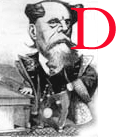 ickens' close friend Frank Stone, artist and actor in Dickens's amateur
theatricals, provided illustrations for The Haunted Man, Nicholas Nickleby, and
Martin Chuzzlewit.
ickens' close friend Frank Stone, artist and actor in Dickens's amateur
theatricals, provided illustrations for The Haunted Man, Nicholas Nickleby, and
Martin Chuzzlewit.
Born in Manchester at the turn of the nineteenth century, Frank Stone left a secure position in his family's textile firm in 1824 to become a free-lance artist. Even though he had no formal training, his portraits had sufficient sentimental appeal to attract the attention and friendship of such established London artists as Daniel Maclise, George Cattermole, William Makepeace Thackeray, William Powell Frith, Augustus E. Egg, John Everett Millais, and Mulready. In the mid-nineteenth century Frank Stone also served as the principal fine arts reviewer for the influential literary journal Athenaeum. As such, he published several unfavorable reviews of the works of the Pre-Raphaelite Brotherhood and was an early and vocal opponent of the Pre-Raphaelite style.
Dickens first became acquainted with Frank Stone, one of the founding members and Secretary of the Shakespeare Society, in March, 1838. Although the society lasted from 1837 to 1839, "Old Tone" (as Dickens affectionately refers to him in his correspondence after 1847) was often a member of Dickens's subsequent amateur theatricals. As a self-proclaimed expert on period costume, Stone insisted on providing suggestions that were often illogical and erroneous. He had supporting roles in Dickens's amateur productions of Ben Jonson's Every Man in His Humour, the lightweight accompaniment Comfortable Lodgings, and Shakespeare's Merry Wives of Windsor in 1847, in Animal Magnetism the following year, in Poole's farce Turning the Tables in 1850, and as the Duke in Edward Bulwer-Lytton's five-act historical comedy Not So Bad as We Seem in 1851. After being a proverbial mill-stone around director-manager Dickens's neck for five years, he turned in a competent performance in the title role of Mr. Nightingale's Diary (a short farce by Dickens and Mark Lemon). In the company of Stone, Leech, and Lemon (whom he dubbed "The Walking Club") Dickens set off on long walks each week.
After 1851 Stone became a neighbour as well as a close friend. In July, 1851, for 1,500 pounds Dickens purchased the large and conveniently located Tavistock House (just north of the British Museum) from Stone, who, unable to keep up the mansion by himself, had been renting out half of it. In later years, when Stone was invited to deliver a speech in his native Manchester, to which he was returning for the first time since 1824, Dickens agreed to write it for him. Helped financially by his recent elevation to the status of associate of the Royal Academy of Art, in the summers of 1853 and 1854, Stone and his family vacationed with the Dickenses at Boulogne on the French coast.
At age 59, Frank Stone died suddenly of an aneurism and was buried in Highgate Cemetery; his life-long friend Dickens, in his capacity as executor, purchased the plot, made the funeral arrangements, counseled the family, provided the artist-son, Marcus, with letters of introduction, and undertook to teach the other son, Arthur, short-hand in order to equip him for employment as a journalist or court-reporter. Dickens recommended his son Marcus (1840-1921) to his publishers. Marcus illustrated Great Expectations and Our Mutual Friend. The younger Stone's figures are more realistic and less caricatures than his predecessors. Marcus later gave up book illustration and became an accomplished painter.
Created 16 February 2005
Last modified 26 December 2019